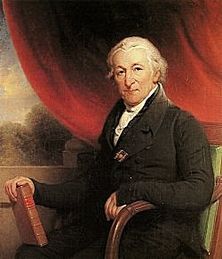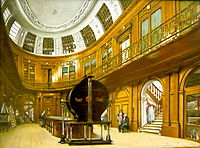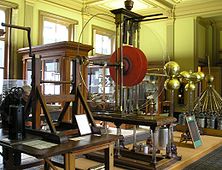
Martin van Marum
Encyclopedia

Delft
Delft is a city and municipality in the province of South Holland , the Netherlands. It is located between Rotterdam and The Hague....
– December 26, 1837, Haarlem
Haarlem
Haarlem is a municipality and a city in the Netherlands. It is the capital of the province of North Holland, the northern half of Holland, which at one time was the most powerful of the seven provinces of the Dutch Republic...
) was a Dutch
Netherlands
The Netherlands is a constituent country of the Kingdom of the Netherlands, located mainly in North-West Europe and with several islands in the Caribbean. Mainland Netherlands borders the North Sea to the north and west, Belgium to the south, and Germany to the east, and shares maritime borders...
scientist and teacher, who studied medicine and philosophy in Groningen. He became famous for his demonstrations of the Leiden jar with his electricity machine while curator for the Teylers Museum
Teylers Museum
Teyler's Museum , located in Haarlem, is the oldest museum in the Netherlands. The museum is in the former home of Pieter Teyler van der Hulst . He was a wealthy cloth merchant and Amsterdam banker of Scottish descent, who bequeathed his fortune for the advancement of religion, art and science...
.
Biography


Haarlem
Haarlem is a municipality and a city in the Netherlands. It is the capital of the province of North Holland, the northern half of Holland, which at one time was the most powerful of the seven provinces of the Dutch Republic...
in 1776 because the Haarlemmers had more taste in the sciences than anywhere else in the Netherlands. After his arrival in Haarlem he began to practise medicine, but devoted himself mainly to lecturing on physical subjects and creating instruments to demonstrate physical theory. He must have made a big impression on Haarlem society, because he became member of the Dutch Society of Science in the same year, but was named director and curator of their cabinet of curiosities in the next year. He received at first no salary, but by scaring off the former cabinet concierge Nicolaus Linder, he was able to collect Linder's' salary of 100 guilders, and when the cabinet moved later in 1777 to new quarters in the Grote Houtstraat 51, van Marum lived there as concierge. He managed to scare off Linder by obtaining permission from the society to allow his servants to keep tips they received from cabinet visitors; a source of income that Linder had come to rely on. Then van Marum increased this salary to 300 from 100 by adding responsibilities to his list of duties, such as a summer garden in the Rozenprieel and eliminating other expenses.
Curator of two museums
In 1779 he was entrusted with the care of the Second society left to Haarlem by Pieter Teyler van der HulstPieter Teyler van der Hulst
Pieter Teyler van der Hulst was a wealthy Dutch Mennonite merchant, who died childless, leaving a legacy of two million florins to the pursuit of religion, arts and science in his hometown, that led to the formation of Teyler's Museum. This was not the value of his entire estate...
(1702-1778), which led under his direction to the foundation of the Teylers Museum
Teylers Museum
Teyler's Museum , located in Haarlem, is the oldest museum in the Netherlands. The museum is in the former home of Pieter Teyler van der Hulst . He was a wealthy cloth merchant and Amsterdam banker of Scottish descent, who bequeathed his fortune for the advancement of religion, art and science...
. The Teyler legacy was split into three societies, one for religion, one for science, and one for the arts, known as the first, second, and third societies. The caretakers had to meet in Teyler's home weekly, and each society had 5 caretakers, so all of the gentlemen involved lived in Haarlem. In 1794 van Marum became secretary as well as director of the Dutch Society of Science. Under his management, both societies were advanced to the position of the most noted in Europe. Period travelogues mention both Museums.
Merging societies, separate collections
Under his guidance the two societies slowly merged. His name is associated with the Electriseermachine, the largest electricity demonstration machine with Leiden jars built in the 18th century and at the time a crowd pleaser for the young Teylers museum. The demonstration model is still on display, as is a smaller version in the Museum Boerhaave of Leiden. Van Marum's researches (especially in connection with electricity) were remarkable for their number and variety. The Teyler's Museum kept its role as a museum of scientific research (some of the periodical subscriptions he started are still running) and is a repository of important scientific demonstration models from the period. Not only items regarding electricity, but also weather stations, industrial models, steam engines, and other examples of the budding industrial revolution were collected and lovingly displayed. The collection of the Teyler's was mostly based on scientific theory, while the collection of the Dutch Society of Science was mostly based on scientific practise. The rooms in the Grote Houtstraat were filled with stuffed animals and other "naturalia", while the summer garden was a modern continuation of Linder's old Linnaeus hortus once located behind the original city hall quarters in the Prinsenhof. Since Linder had not known any Latin, it was easier for Van Marum to entertain foreign visitors with stories of Linnaean trivia and of course, the Haarlem story of tulip maniaTulip mania
Tulip mania or tulipomania was a period in the Dutch Golden Age during which contract prices for bulbs of the recently introduced tulip reached extraordinarily high levels and then suddenly collapsed...
.
Teylers
In 1784, when the Teylers Museum opened its new 'Oval Room', Vincent Jansz van der Vinne was hired as curator of the art collection and lived in the "Fundatiehuis" (abbreviation for the former residence of the foundation's founder Pieter Teyler) as concierge. He left the next year because of continuous disagreements with van Marum over art and the opening hours of the museum. Van der Vinne was an artist born into an important Haarlem artist family - he was the grandson of Vincent van der VinneVincent van der Vinne
Vincent Laurensz van der Vinne was a Dutch Mennonite painter, linen-weaver, and writer.- Biography :He lived and worked in Haarlem and was a student of Frans Hals for nine months in 1647. In 1649 he became a member of the Haarlem Guild of St. Luke. In 1652 he left on a Grand Tour through Germany,...
. The Teyler's museum replaced him with another local artist, Wybrand Hendricks
Wybrand Hendricks
Wybrand Hendriks , was a Dutch painter and the concierge of the Teylers Museum.-Biography:...
, who painted the famous oval room and many other Haarlem scenes. Hendricks is largely responsible for the Teyler's collection of Old Master
Old Master
"Old Master" is a term for a European painter of skill who worked before about 1800, or a painting by such an artist. An "old master print" is an original print made by an artist in the same period...
prints, most notably the purchase in Rome 1790 of a print & drawing collection formerly owned by Christina of Sweden
Christina of Sweden
Christina , later adopted the name Christina Alexandra, was Queen regnant of Swedes, Goths and Vandals, Grand Princess of Finland, and Duchess of Ingria, Estonia, Livonia and Karelia, from 1633 to 1654. She was the only surviving legitimate child of King Gustav II Adolph and his wife Maria Eleonora...
. Apparently he got along under van Marum, but when he left in 1819 at the age of 75, the Teyler's decided to discontinue the purchase of art "for the decline in art enthusiasts in this city".
During the tenure of Hendriks, van Marum himself was busy giving public demonstrations of electricity in the Oval room, but was also collecting in this period (this is why he was so involved with the lifestyle of the concierge of the Fundatiehuis, since he was there every day). He concentrated on scientific publications for the Teyler library. He concentrated his efforts on three aspects: 1) Greek and Latin authors, among them the church fathers, 2) Works of natural history including travelogue
Travel literature
Travel literature is travel writing of literary value. Travel literature typically records the experiences of an author touring a place for the pleasure of travel. An individual work is sometimes called a travelogue or itinerary. Travel literature may be cross-cultural or transnational in focus, or...
s, and 3) natural history periodicals, including all publications of the Royal Society of London and all publications of the Dutch Society of Science, which Teyler had been a member of, but could not be on the board of, due to religious differences with the board. The criteria for purchase was always expense. If a Society member could afford to purchase it himself it was not worth adding to the collection. Any member could suggest purchases, however, which explains why the collection is filled with richly illustrated examples of contemporary publications. The most impressive of these are the large illustrated books of travellers. To view the collection, van Marum organized gentleman evenings in Pieter Teyler's library, a tradition that still exists.
Legacy
Though the public is allowed access during the day to the museum rooms, the private rooms of Pieter Teyler in the "Fundatiehuis" are only open one day a year, on Monument Day. Because of its rich scientific tradition, many noted scholars of Physics moved to Haarlem to work at Teyler's, including Nobel prizeNobel Prize
The Nobel Prizes are annual international awards bestowed by Scandinavian committees in recognition of cultural and scientific advances. The will of the Swedish chemist Alfred Nobel, the inventor of dynamite, established the prizes in 1895...
winners Pieter Zeeman
Pieter Zeeman
Pieter Zeeman was a Dutch physicist who shared the 1902 Nobel Prize in Physics with Hendrik Lorentz for his discovery of the Zeeman effect.-Childhood and youth:...
and Hendrik Lorentz
Hendrik Lorentz
Hendrik Antoon Lorentz was a Dutch physicist who shared the 1902 Nobel Prize in Physics with Pieter Zeeman for the discovery and theoretical explanation of the Zeeman effect...
.
Of van Marum's three categories, only the first was discontinued at the close of the 19th century. The collection of periodicals which has been expanded through exchange networks, contains uninterrupted series that are among the oldest in the world.
The Teyler's museum created a new wing in 1996 to house a rotational display of van Marum's library collection, such as the works of John James Audubon
John James Audubon
John James Audubon was a French-American ornithologist, naturalist, and painter. He was notable for his expansive studies to document all types of American birds and for his detailed illustrations that depicted the birds in their natural habitats...
in combination with contemporary stuffed birds of Naturalis
Naturalis
Naturalis is the national natural history museum of the Netherlands, based in Leiden. It originated from the merger of the Rijksmuseum van Natuurlijke Historie and the Rijksmuseum van Geologie en Mineralogie in 1984. In 1986 it was decided that the museum had to become a public museum and a new...
.
External links
- Noord-Hollandsarchief Archives of North Holland
- Teylers Museum (in Dutch)
- Dutch Society of Science (in Dutch)

